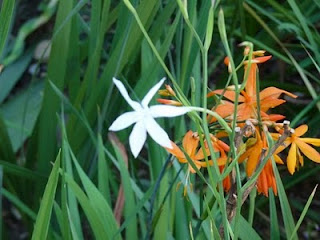



This is supposed to be Gladiolus candidus, grown from seeds from Silverhill, and the plant does look like a small gladiolus, but the description I have in books does not seem to match the flowers. The flowers are perfectly regular, a rarity in the genus, and the seeds are large and round without the flattened wing typical of gladiolus seeds. If it is a gladiolus, it must be a very primitive basal species. It is a charming plant, easily grown from the rather pointy small corms, which seem to double each year. The long tubed white flowers are obviously adapted for moth pollination in their native habitat. I doubt it has cold tolerance, so I dig the corms up and overwinter them inside. From the appearance of the seeds I suspect it could be a summer rainfall species of Lapeirousia--and there is always the possibility I got the labels on the seedpots mixed up. UPDATE: I have gotten a good identification on this plant, it is Lapeirousia schimperii, a summer growing rather tall member of a genus which is usually winter growing and much smaller in size. Makes sense as it has corms that resemble other lapeirousias, and as of 2013 it has continued to increase well by corms and set seeds (with some hand pollination).






























